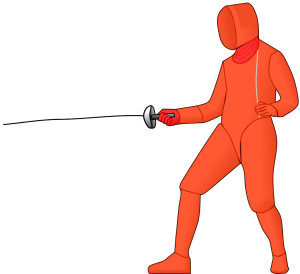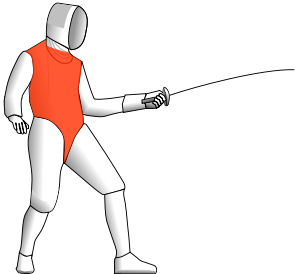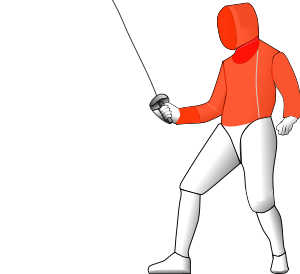Introduction To The Three Weapons
There are three weapons used in fencing: épée, foil, or saber.
Each weapon has its own characteristics, rules, and signature style.
The Épée
The epee has a total length of 110cm and its blade is 90cm long. The total weight of the weapon must be less than 770g. Like the foil, the epee is a thrusting weapon only and the epee attack is with the point of the weapon only.
With the epee, the target area is the entire body, head to toe, including any clothing and equipment.
Unlike the sabre and the foil, with the epee there are no right of way rules regarding attacks. Any hit which is made is counted. Hits are awarded solely on the basis of which fencer makes a hit first, according to an electrical recording apparatus.
Also, double-hits are allowed in epee, although the hits must occur within 40 milliseconds (1/25 of a second) of each other.
The Foil
 The foil has a total length of 110cm and its blade is 90cm long. The total weight of the weapon must be less than 500g.
The foil has a total length of 110cm and its blade is 90cm long. The total weight of the weapon must be less than 500g.
The foil is a thrusting weapon only. Fencers can only score a hit by striking the point of their weapon on the defined target area of their opponent, which is limited to the torso only.
Non-valid hits also stop the bout, but are not counted.
The foil is governed by the rules of right of way. The fencer who starts an attack has the right of way. In order to avoid being hit, the opposing foil fencer usually attempts to parry the attack and, if this is successful, riposte. To avoid being parried, the attacker may use several tactics, such as disengages or coupes, which are different ways to avoid the opponents’ blade.
The Sabre
The sabre has a total length of 105cm and its blade is 88cm long. The total weight of the weapon must be less than 500g.
The basic difference between the sabre and the two other weapons is that a hit can be made with the cutting edge, not just with the point. The target area consists of everything above the waist, including the head and both arms.
Like the foil, the sabre is governed by the rules of right of way. The fencer who starts an attack has the right of way.
In order to avoid being hit, the opposing sabre fencer usually attempts to parry the attack and, if this is successful, riposte. To avoid being parried, the attacker may use several tactics, such as disengages or coupes, which are different ways to avoid the opponents’ blade.
